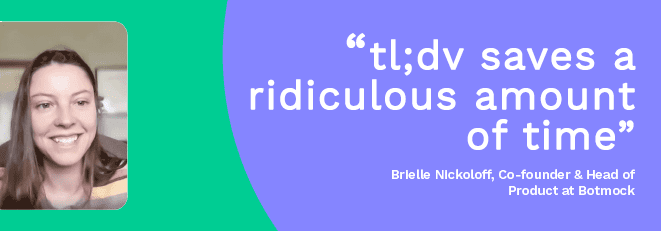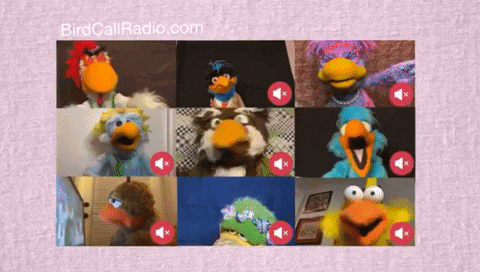Here at tl;dv, we’ve held over 3356 meetings, with 0 absentees, ever.
That’s over 211,428 meeting minutes without a single employee missing out. Yet, our employees are happy, healthy, and even productive! Since we’ve begun, not a single team member has left our close-knit team of 13.
Do we have sick days? Yes.
Do we sometimes have unproductive days? Yes.
Do we take annual leave days and weeks to go surfing, skiing, wakeboarding, and camping? Hell yes!
But that doesn’t have to equate to absent employees and meetings with “absentees”. Unlike the above blog cover GIF, which demonstrates the usual push-and-pull between absence and productivity, we think teams can have both, without any collateral damage. We’re going to show you how. Hint: the answer lies in recording your meetings. Side note: thanks to the Greek God of Precise Knowledge, Marios Balamatsias for these precise meeting figures!
In this article
The problem: Absent employees are costly

So we know the rhetoric… Presenteeism = bad, absenteeism = less bad. Here is where the conundrum arises. If both outcomes are not ideal, then are teams and companies simply aiming for the lesser of the two evils? It would appear so. However, we believe (and know) that “presenteeism” doesn’t have to come at the expense of employee productivity, happiness, or even health.
Through the miracle of modern invention, employees can catch up on vital happenings whilst they’re away, sick, or on holiday, via email, Slack, Trello, Notion, and an array of other communication platforms and tools. Thus, written communication is forever preserved in most companies and teams. This has the effect of making the absent employee asynchronously present.
But what about verbal communication? The exchange of spoken words that are the lifeblood of any company culture? How do we preserve these for “absentees”?
So when an absent employee returns to work, should we just throw away all the vital information, decisions, team cohesion, and competitor and company updates communicated in these gatherings? Or should we reduce these to a few meeting minutes and share them via another email, only to be buried in one’s inbox?
No.
Absolutely not.
Rather, we record our meetings.
With a click of a button, your “present” team members can continue going about their days. The only difference is now they can simply record meetings for the benefit of “absent” team members. This requires no extra time or effort. In fact, this is drastically less time-consuming than drafting meeting minutes. So that’s the solution. However, the benefits are likely more far-reaching than most realize. We’re going to unpack these now!
The solution to absenteeism is to redefine presenteeism

Technology has pushed the boundaries on what can be considered “present” or “absent”. People can chat live whether from home-office or a swanky holiday resort. Emails can be replied to seconds or weeks later. Heck, people can now work almost entirely remotely from their mobile phones. Yet, many still define “absence” and “presence” based on the notion of synchronous attendance.
We think the key to mitigating the impacts of “absenteeism” is to redefine it. Employees are not really “absent” if they’ve caught up on all meetings, emails, messages, and important information efficiently and effectively upon their return. They’re just simply asynchronously present. 💡
So, the solution is to redefine absences and presence in your company. Here’s how we define absenteeism and presenteeism at tl;dv.
- Absence: vital to employees, absences are when employees take time off work for a variety of reasons. The goal is to recharge and recover so that they're in the best position to carry out their work duties upon return.
- Absenteeism: an unfamiliar concept that doesn’t exist in tl;dv. We don’t focus on “absenteeism” - in the traditional sense of the word in our team. Rather, we focus on getting employees up to speed at quickly as possible through thorough meeting and communication documentation, recording and sharing.
- Presence: an employee that engaged with the team either live or asynchronously. This can be in the form of face-to-face, verbal, or written communication and collaboration.
- Presenteeism: the phenomenon where team members are 100% present during critical moments at work (e.g., meetings and other key communication periods) either live or asynchronously.
So, now that we’ve established the problem and the solution, let’s bask in the joys of the benefits. 🙌 As many of you already know and love asynchronous text communication (emails, Slack, DMs), we’re going to be focusing on meetings as the last missing and integral piece of this presenteeism-puzzle.
Level 1 benefit: Presenteeism that is not harmful
Through re-defining what it means to be “absent” and “present” you can minimize absences and the negative impacts from traditional notions of “presenteeism”. Most workplaces already do this with Slack and email. We’re going to show you how to do this by recording meetings too!
Presenteeism ≠ a cost to the business
Forcing employees to come into work when unwell costs. In fact, in Australia, the cost of traditional presenteeism was estimated at $25 billion each year. If you’re recording your meetings, employees no longer need to attend work when they’re feeling unwell or unproductive. Rather, you and your team can feel completely free to take leave as needed when needed with the confidence of knowing they can easily catch up on important information via Slack, email, and now through recorded meetings with tl;dv.
Presenteeism ≠ unhealthy employees
This brings us to our next point – reducing pressure to attend work when unwell. By mitigating the burden of “absences” your employees can fully rest and recharge without worrying about missing vital information. One study estimates that purely investing in employees’ mental health could result in cost savings of 30%. That’s £250,607 a year for every 1000 employees.
The benefit is clear: reduce pressure for employees to be synchronously present, by utilizing technologies that make it easy for employees to catch up on important information easily when they return. This reduces pressure to come to work when unwell.

Level 2 benefit: Presenteeism that actually helps
Okay, so you’ve mitigated the negative impacts of traditional “presenteeism”. Now, the next step is to use these same tools and frameworks for increased benefit!
Presenteeism = being productive
A recent study shows that employees are interrupted every 3 minutes and 5 seconds. Sheesh. After these interruptions it takes 23 minutes it takes to refocus. Suddenly, the power of Deep Work becomes clear. Deep Work is some of the most productive and important times in any employee’s day. It is their time to strategize, iterate, think and focus.
Many are taught that being omnipresent, especially in meetings is proper etiquette. Traditional presenteeism (i.e synchronous attendance) used to come at a cost to Deep Work. Our definition of being “present”, which allows for synchronous or asynchronous attendance allows for employees to guard their time, resulting in fewer distractions.
Through having the confidence that all messages, emails and also meetings can be caught up on asynchronously, your employees can have the confidence to say “no” to non-essential synchronous meetings that interrupt their Deep Work time.
Presenteeism = saving time

So, you’re the manager of a team and you don’t want your “absent” employees to miss-out on important meeting takeaways, action items and next steps. Don’t spend copious hours writing lengthy meeting wrap ups for the 5% of people who were “absent”. Record them instead!
You’ll save time writing lengthy meetings notes. But, how about the people catching up on the meeting asynchronously? Well, they’ll save a lot of time too!
tl;dvs can be rewatched at up to 2x the speed. Rather than trawling through lengthy and context-lacking meeting minutes, “absentees” can skip right to the most relevant section in any recorded meeting with our timestamped highlights feature! Looking for a particular moment in the meeting? Then search for it via our transcript function. This is a game-changer regardless of the absenteeism vs presenteeism debate! So, why not catch up on your meetings in minutes? 🤘
Presenteeism = team cohesion

Congratulations! You’ve cracked the presenteeism-code and now “absent” teammates can catch up on any important note or FYI upon their return. Would you like a side of “team cohesion” to go with that? 🍟
Simply put, reading meeting minutes don’t capture the full force of a team’s dynamics – their joy, pain points, and emotions. Recorded meetings capture this so much better. As we know 93% of communication is non-verbal. Through sharing recorded meetings with your team, you’re not only mitigating the negative impacts of being “absent”, but are also serving that mitigation with a side of team bonding and harmony.
Bon appétit.
Level 3 benefit: Mastering presenteeism
This is the highest level attainable in presenteeism-positivity. When you start doing these things, you’ll know you have implemented truly robust leave policies and working habits. Congratulations!
Present = forever

We’ve shown you how automatically recording your meetings can help mitigate the negative implications of “absenteeism”. We’ve also shown you how recording meetings can lead to productive and healthy “presenteeism”. In a presenteeism-positive culture, being present also means being timeless. Your Slack messages, emails, and now your meetings are no longer ephemeral.
Have your communication, collaboration, and meetings in the present. But also record, preserve and save them for the future. For future learning, future collaboration, future onboarding and future inspiration.
This is how you truly level-up your presenteeism-posivity game!
Mastering presenteeism = encouraging and celebrating absences

However, there is no greater hallmark of a company that has mastered presenteeism than not being afraid of absences but actually encouraging them. This shows that one has truly managed their absence-employee practices and mitigated any negative impacts from “absences”. Don’t be hesitant to let your employees take well-deserved time off. Rather manage how efficiently and quickly you get them back to speed upon their return. Here’s a message I received from Carlo, tl;dv’s Co-founder and COO. That’s his title, but really he’s the Chief Happiness Officer, as he keeps all of the cogs turning (happily and efficiently) in tl;dv. 💜

Final thoughts on presenteeism
Being present 100% of the time ≠ unhealthy employees.
Being absent in meetings ≠ lack of team harmony and cohesion.
Being present 100% of the time shouldn’t come at the cost of your employee’s health and happiness. We live in a day and age of abundant asynchronous and synchronous communication and collaboration tools. Rather than worrying about presenteeism or absenteeism we should redefine company attendance and leave policies and culture in accordance with this technology. Re-direct your focus towards getting your team up-to-speed as efficiently and effectively when they return. These are not just empty words from a company trying to sell you its wares – these are lived experiences. These are tested theories. These are HR policies that we live, breathe, and stand by.
So, we say take a day, go on an epic holiday, skip a meeting, and encourage your employees to do the same.
Just watch the darn tl;dv when you get back.














